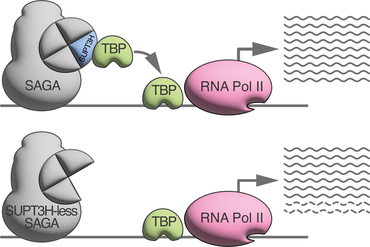Functional difference of the SAGA transcription coactivator complex between yeast and mammals
In a study published in Nucleic Acids Research, scientists focus on the function of transcription coactivator complexes by RNA polymerase II (Pol II). Conserved in yeast and mammals, the researchers identify different functions of the transcription coactivator complex Spt Ada Gcn5 Acetyltransferase (SAGA). In both species, the SUPT3H subunit is not required for SAGA assembly. In this study, the authors show that in mammals, SUPT3H is also not required for Pol II initiation and global transcription, affecting only a subset of genes in mammals.

The formation of the pre-initiation complex (PIC) of transcription is a major step for gene expression in eukaryotes. Essential for PIC formation, chromatin accessibility is mediated by transcriptional co-activators such as the SAGA complex. The latter is conserved in eukaryotes and has an octameric central organization similar to a nucleosome.
In yeast, SAGA has been shown to participate in the transcription of almost all genes. In addition, two subunits of SAGA: Spt3, an ortholog of SUPT3H, and Spt8, interact directly with the TATA box binding protein. This suggests that SAGA is also involved in the regulation of TBP deposition on promoters. The absence of Supt3 does not affect the formation of the SAGA complex but induces an overall decrease in Pol II transcription indicating that Supt3 contributes to the transcription of almost all genes in yeast.
In this study, scientists investigate the role of SUPT3H in SAGA assembly, regulation of Pol II transcription and recruitment of TBP to promoters in human and mouse cells. As observed in yeast, the absence of SUPT3H does not affect SAGA complex formation. In contrast, SUPT3H is only required for the expression of a limited number of genes, including those involved in murine embryonic stem cell growth and turnover. The absence of SUPT3H does not affect the recruitment of TBP to promoters with or without TATA boxes. These data suggest that the role of SUPT3H in transcription regulation has diverged during evolution and that yeast or mammalian SAGA complexes contribute to transcription regulation by different mechanisms.
